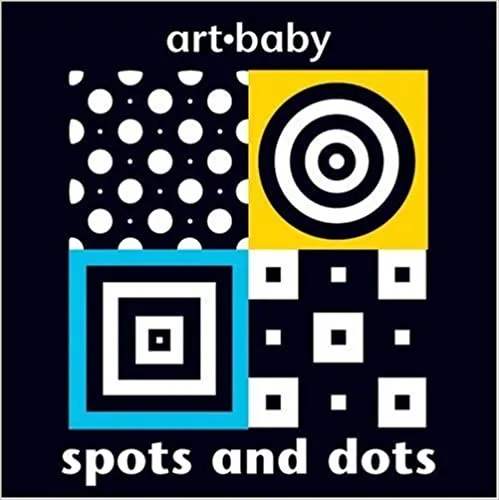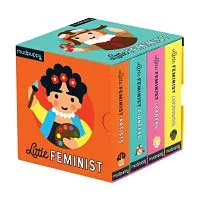
What Makes A Good Board Book?
I don’t think I understood the importance of board books until I had a child of my own. Before having a child, I thought the stories in board books were too short and the art too childish. They weren’t as interesting or appealing as picture books, which I collected long before having children. But now, as a parent, I experience board books in a whole new way.
One of my infant daughter’s first friends was a high contrast board book called Spots and Dots. There are no words in this board book, just colors and patterns. My daughter would sit and stare at the illustrations, giving the book her undivided attention, smiling when she began to smile, babbling to the illustrations when she began to babble. When I propped the book up for her to see, her expression would transform to that of someone meeting a dear friend after a long time of separation and needing to catch up on everything they’d missed. It was amazing to watch.
Then came the teething phase. Board books were my daughter’s favorite teethers. While she’s chewed on almost all her board books, the tiny Little Feminists and Little Scientists board book sets got it the worst. They’re smaller than most board books, making them perfect for little hands to hold and for little mouths to gnaw on.
Now at three and a half, my daughter gravitates towards silly board books, ones that perfectly encapsulate a toddler’s sense of humor, as well as interactive stories, either with flaps or ones that ask the reader to participate in the story. Her tastes in board books have changed depending on her age and stage, so answering the question “What makes a good board book?” isn’t a simple one. Board books are complex, specifically geared towards certain ages. While I didn’t much like board books before having a child, that’s because they were never for me. Now that I’ve found an appreciation for board books via parenthood, I decided to delve into the question of what makes a good board book. Picture books tend to take front and center in the children’s book market, yet board books have such an essential role in early childhood development.
To get to the bottom of what makes a good board book, I talked with two teachers, a librarian, and many of my fellow children’s Bookstagrammers for their opinions. Several themes became apparent.
Durability
Montessori preschool and kindergarten teacher Ashley Speed (she/her) of @AshSpeedTeaches pointed out that board books “are generally the first introduction to books children get. We do a disservice to children by ignoring them — the fact that they are more solid and durable and shorter is a PLUS in this case. You WANT children to love books hard and enthusiastically, and board books allow the littlest baby bookworms to begin their hopefully lifelong love of reading.”
“We want young children to have the tactile experience of turning pages and handling books,” added early childhood educator and literacy specialist Jodie Rodriguez of @GrowingBookByBook. “Because picture books are more expensive and easy to tear, we often avoid these books with babies and toddlers and miss the reading experience. Board books allow everyone involved to feel welcome to handle and explore the pages. And, because young children love to have stories reread countless times, board books hold up to these repeated readings. Secondly, board books are cheaper than picture books making them a better price point to acquire.”
Their durability and lower price make board books a much better option for children who have yet to fully develop their fine motor skills. Parents don’t have to sweat it letting their young children play with board books, and kids get to practice those fine motor skills as they turn pages and enjoy a tactile experience with books.
Accessibility
Larger board books can be problematic, and many of the educators, literacy specialists, book reviewers, and parents I spoke to mentioned the need for board books to be appropriately sized for little hands. Debra @LilReaderThatCould said she’s “not a big fan of large board books that are too heavy for little ones to manipulate by themselves. The beauty of a board book is giving babies access to independently explore books!”
Safe, rounded edges are also important, as is big, bold text.
Eye-Catching Illustrations
“I see children gravitate toward books that have an eye-catching cover,” said literacy and media specialist Stephanie Willis @TheLiteracyParty. “Oftentimes, an eye-catching cover for my students [has] bright colors [and] recognizable characters […] When I am choosing board books for littles, I look first and foremost at the illustrations.”
High contrast for infants, vivid colors, engaging photographs: there are many ways for board books to have eye-catching illustrations. While many people I interviewed mentioned colorful illustrations as key to a board book’s popularity, it’s also important for these illustrations not to be too overstimulating visually, as Elizabeth @TheKidLitMama mentioned. Developing eyes need to be able to pinpoint what to focus on.
Inclusivity
“Board books are the first exposure our children have to the world and therefore representation and inclusivity during primary experiences is imperative,” Stephanie Willis stated. Inclusivity was a must for several more of the people I interviewed. “[Children] love to see themselves reflected,” @EcoCraftKids pointed out, “so diversity is always very important.” Even for white, non-disabled infants and toddlers, it’s important to see diversity in illustrations, a diversity that is quite possibly absent from their daily interactions. A study showed that by the age of 3, children already associate negative traits based on race. That makes inclusive board books essential.
Interactive
Alessandra Requena of @ReadWithRiver argued that “Board books are essentially toys as well as reading material, and so seeing that explored is really helpful.” She specifically mentioned Phaidon and Cottage Door as having super fun and innovative board books that push the boundaries of what’s possible in the board book format.
While flaps are always a big hit with little ones, Jo @TheLittleLiterarySociety mentioned that “if it has flaps, make them felt flaps that are indestructible.” I know I’m not the only one with a bunch of Usborne lift-the-flap board books at home that no longer have any flaps.
Mirrors, sensory elements, finger puppets, and books that ask the reader to participate in the story are also super engaging for littles.
Excellent Read-Alouds
What became clear from everyone’s responses is that a great read-aloud in a board book is hard to capture and nebulous to pinpoint.
Lauren from @Jojos_Book_Club doesn’t love picture books made into board books. “My 2-year-old needs different things than my 7-year-old,” she pointed out. For one thing, toddler and infant attention spans are shorter. Yet, board books with only a single word per page can be incredibly dull to read, as Kelly @InclusiveStoryTime mentioned.
Hanna @MyLiteracySpace argued for shorter lengths, repetitive phrases, simple text, and concrete concepts; yet, asserted Sue @Reaching_Happy, they need to be “enjoyable enough for parents to read 12+ times per day.” An excellent rhythm and rhyme seem to be key to a board book’s read aloud-ability, but simplicity is important too. Humor is always a hit, too. Every toddler I know loves a funny board book specifically geared towards a child’s sense of humor. I’ve personally found that seeing my daughter’s delight in a board book makes the reading experience more enjoyable for me as well, even if we’ve read a book 20+ times in a row.
“The best board books are the ones that teach in an authentic way that entertains, engages, and inspires kiddos to take the book into their play and their imagination,” said Shannon @TheLarkspurAndTheWaterLily, who has previously taught pre-K. Teaching concepts and messages are essential, but it has to be entertaining first.
So, what were some of the favorite board books mentioned in my interviews? The Global Baby series, Peek-a-Who? by Nina Laden, The Last Marshmallow by Grace Lin and the others in the Storytelling Math series, Guess Which Hand by Hans Wilhelm, Rhymoceros and the rest of the Grammar Zoo series by Janik Coat, and Baby’s First Words by Stella Blackstone, Sunny Scribens, and Christiane Engel. I’d like to add the We Are Little Feminists board book series, and for felt lift-the-flap board books, the Where’s the… series by Ingela P. Arrhenius, such as Where’s the Owl?
For more must-read board books, check out this list of high-contrast board books (which are essentials for infants), this list of black and white board books, this one of interactive board books, and this list of 50 essential board books.












